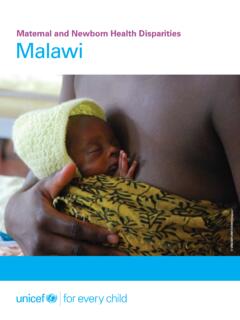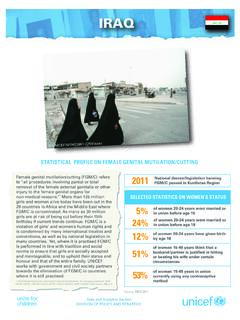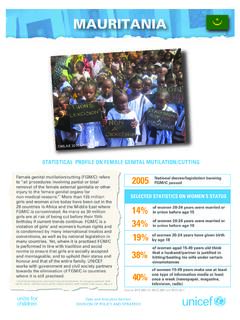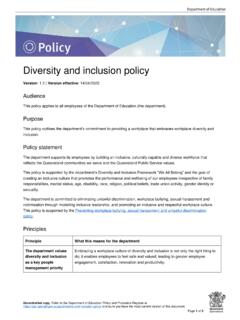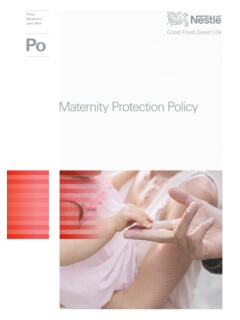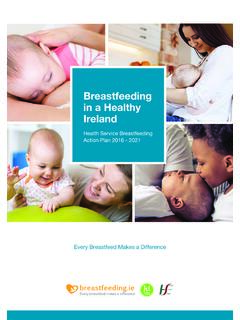Transcription of BREASTFEEDING - UNICEF DATA
1 A Mother s Gift, for Every ChildBREASTFEEDING United Nations Children s Fund ( UNICEF ), 2018 Permission is required to reproduce any part of this publication. Permission will be freely granted to educational or non-profit contact: Nutrition Section, Programme Division, UNICEF 3 United Nations Plaza, New York, NY 10017, creditsCover: UNICEF /UNI166592/LiuPage iv: UNICEF /UN0155822/ZammitPage 7: UNICEF /UNI194031/KrepkihPage 8: UNICEF /UNI115671/NesbittPage 10: UNICEF /UNI122810/AsselinAcknowledgements This report was prepared by UNICEF s Nutrition Section, Programme Division, Data and Analytics Section, Division of Data, Research and Policy, and Division of team: Maaike Arts, Vrinda Mehra, Guy Taylor Data and analysis: Vrinda Mehra, Julia Krasevec, Chika Hayashi Policy analysis.
2 France B gin, Victor M. Aguayo Fact checking: Xinyi Ge, Yasmine Hage Graphic design: Nona Reuter, QUO Global Advocacy and communications: Kurtis Cooper, Shushan Mebrahtu, Sabrina Sidhu, Guy Taylor, Irum TaqiA Mother s Gift, for Every ChildBREASTFEEDING1 BREASTFEEDING A Mother s Gift, for Every ChildBreastfeeding: A Mother s Gift, for Every ChildThe importance of BREASTFEEDING BREASTFEEDING , initiated within the first hour of birth, provided exclusively for six months, and continued up to two years or beyond with the provision of safe and appropriate complementary foods, is one of the most powerful practices for promoting child survival and wellbeing.
3 Improving BREASTFEEDING rates around the world could save the lives of more than 820,000 children under age 5 every year, the majority (87 per cent) under 6 months of In addition to improving child survival and protecting against life-threatening and chronic illnesses, BREASTFEEDING promotes healthy growth and boosts early child development. BREASTFEEDING supports healthy brain development, and is associated with higher performance in intelligence tests among children and adolescents across all income But BREASTFEEDING is not just good for babies, it is good for mothers as well. Indeed, BREASTFEEDING has been shown to protect against post-partum haemorrhage, postpartum depression, ovarian and breast cancer, heart disease and type 2 It is estimated that improving BREASTFEEDING rates could prevent an additional 20,000 maternal deaths from breast short, BREASTFEEDING is among the most effective ways to protect maternal and child health and promote healthy growth and optimal development in early childhood.
4 Empowering and enabling women to breastfeed should be at the heart of countries efforts to keep every child alive and to build healthy, smart and productive global picture Analysis of data from 123 countries (see Annex) shows that around the world most babies are breastfed at some point in their lives, with 95 per cent of babies ever receiving breastmilk. However, this rate varies widely between low- and middle-income, and high-income countries. In low- and middle-income countries, just 4 per cent, or 1 in 25 babies, are never breastfed. In high-income countries, 21 per cent of babies, or more than 1 in 5, never receive and WHO recommend: Initiation of BREASTFEEDING within the first hour of life.
5 Exclusive BREASTFEEDING , without any additional food or fluids, not even water, for the first six months. Thereafter children should receive complementary foods with continued BREASTFEEDING up to 2 years of age or beyond. BREASTFEEDING on demand that is as often as the child wants, day and A Mother s Gift, for Every ChildFigure 1 Share of babies that are breastfed in high-, low- and middle-income high-income countries, there are wide variations in the proportions of babies who are breastfed. In some countries, such as Oman, Sweden and Uruguay, almost all babies are breastfed but in others, rates are far lower: In the USA, 74 per cent of babies ever receive breastmilk; in Ireland, just 55 per cent are breastfed.
6 Such variations are not observed in low- and middle-income countries: Even in countries with the lowest BREASTFEEDING rates nearly 9 in 10 babies are breastfed (see Figure 2). Differences in BREASTFEEDING rates are not only seen between countries with different income levels but also between rich and poor groups within countries. Evidence suggests that in high-income countries, it is mothers from poorer households who are less likely to breastfeed. This is in contrast to low- and middle-income countries, where the small percentage of mothers who do not breastfeed come, for the most part, from wealthier ,6,7In high-income countries, more than 1 in 5 babies are never breasfedIn low- and middle-income countries, almost all babies are breastfedNote: Each coloured circle represents a country within the income group.
7 The figure presented at the top of each column is a population-weighted average. This means that rates of BREASTFEEDING are affected more by the performance of countries with the largest number of births within that column. Figure 2 Percentage of newborns ever breastfed, by country income group, A Mother s Gift, for Every ChildFigure 3 Percentage of children in low- and middle-income countries who are breastfed at 2 years, by wealth quintile and region, the proportion of babies receiving at least some breastmilk is high across all low- and middle-income countries, the length of time for which a mother continues to breastfeed her child varies substantially by the wealth status of the household.
8 Among the poorest families, almost two thirds (64 per cent) of babies are still breastfed at age 2, as recommended by UNICEF and WHO, compared to only 41 per cent among the richest families (see Figure 3). This gap is widest in the West and Central Africa region, where 63 per cent of babies in the poorest families still receive breastmilk at 2 years, compared to only 26 per cent in the richest. The gap between rich and poor groups is smallest in Eastern Europe and Central Asia, where both the wealthiest and poorest families have low rates of BREASTFEEDING at 2 years: 23 and 31 per cent : Analysis is based on a subset of 73 countries with recent (2010 2017) disaggregated data for continued BREASTFEEDING at 2 years.
9 Regional estimates are presented only where adequate population coverage is met (see page 9 for details).Source: UNICEF Global Databases: Infant and Young Child Feeding, quintileRichest quintileAverage of all wealth x x AsiaWest and CentralAfricaEastern and Southern AfricaEast Asia and the Pacific*Latin America and the Caribbean*Middle East and North AfricaEastern Europeand Central Asia*World** x x x x x x * East Asia and the Pacific excluding China, Latin America and the Caribbean excluding Brazil, Eastern Europe and Central Asia Russian Federation.** World excluding China, Brazil and Russian A Mother s Gift, for Every ChildUnderlying causes Many factors contribute to creating a positive environment for BREASTFEEDING .
10 At the national level, policies guaranteeing parental leave and the right to breastfeed in the workplace are critical, as are restrictions on the marketing of breastmilk substitutes. Within health facilities, mothers need information and support to breastfeed immediately after birth, and beyond. Positive social norms that support and encourage BREASTFEEDING , including in public spaces, serve to empower mothers to breastfeed. In communities, support from trained counsellors and peers, including other mothers and family members plays a key role. The support of men, husbands and partners cannot be underestimated. Interventions are most effective when they are implemented in combination, rather than piecemeal or in isolation.
